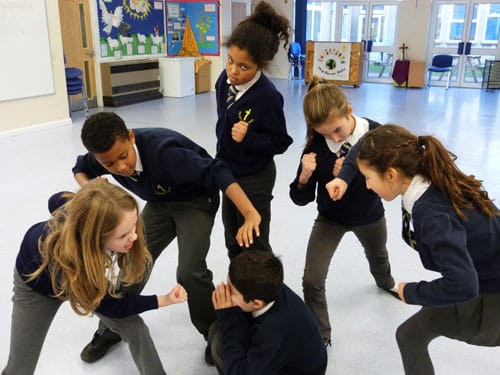What is a tableau?
In a tableau, participants make
still images with their bodies to represent a scene. A tableau can be used to quickly establish a scene that involves a large number of characters. Because there is no movement, a tableau is easier to manage than a whole-group improvisation – yet can easily lead into extended drama activities. It can be used to explore a particular moment in a story or drama, or to replicate a photograph or artwork for deeper analysis.
Performance 2 will be a tableau
October 21
1. vocab quiz (Criterion A)
http://www.quia.com/quiz/7429332.html
2. Tableaux - what is it?
https://www.thoughtco.com/introducing-tableau-to-students-3938471
3.
153 Creating Tableau from
Arts Impact on
Vimeo.
4. Warm-up
Name: Silent Negotiations Purpose: Collaboration
• What are some ways we can communicate with each other without talking?
• Be aware of the ways you collaborate with your group.
Collaboration means
1. You communicate your own ideas, but you also listen to other people. How do you “listen”
when someone isn’t talking?
2. You compromise with one another.
3. You incorporate each other’s input and feedback.
Task 1: In groups of 3-5 (in complete silence) you will create a tableaux:
- Letters of the alphabet A, B, C, D
Task 2: In groups of 3-5 (in complete silence) we will create a tableaux. For instance, I will call out: wedding, funeral, baseball game, playground, school hallway, cafeteria, dungeon, love, hope.
Then I will say: 5, 4, 3, 2, 1 Freeze
5. Tableaux check list
Statue: Individual facial expression and body shape/gesture
• Use whole face and body
• Show character
• Show action (body)
• Show emotion (face)
Levels and depth
• Low/medium/high, left/right/center, downstage, upstage, near/far
• Three dimensional use of stage or playing space
Character and spatial relationships/connections
• Eye contact or point of focus
• Physical contact, using positive or negative space (touching or not touching)
• Proximity or distance
Open to the audience (cheat out)
• Audience awareness
• Make sure all actors can be seen (no blocking—use levels & depth)
October 23
1. Warm up Reflection from October 21
2. Assign tableaux groups
Group 1: Laura, Isabel, Myles, Bavo, Kristian
Group 2: Carolina, Clementine, Brenda, Lison, Francisco, Leo
Group 3: Sofia, Chris, Maria, Sara, Taitum, Elvis
3. In your groups
create a mind-map with various tableaux performance ideas.
4. Select your performance tableaux.
Justify your choice.

